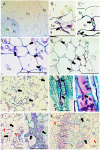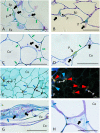Physical and Chemical Barriers in Root Tissues Contribute to Quantitative Resistance to Fusarium oxysporum f. sp. pisi in Pea
- PMID: 29515610
- PMCID: PMC5826057
- DOI: 10.3389/fpls.2018.00199
Physical and Chemical Barriers in Root Tissues Contribute to Quantitative Resistance to Fusarium oxysporum f. sp. pisi in Pea
Abstract
Fusarium wilt caused by Fusarium oxysporum f. sp. pisi (Fop) is one of the most destructive diseases of pea worldwide. Control of this disease is difficult and it is mainly based on the use of resistant cultivars. While monogenic resistance has been successfully used in the field, it is at risk of breakdown by the constant evolution of the pathogen. New sources of quantitative resistance have been recently identified from a wild relative Pisum spp. collection. Here, we characterize histologically the resistance mechanisms occurring in these sources of quantitative resistance. Detailed comparison, of the reaction at cellular level, of eight pea accessions with differential responses to Fop race 2, showed that resistant accessions established several barriers at the epidermis, exodermis, cortex, endodermis and vascular stele efficiently impeding fungal progression. The main components of these different barriers were carbohydrates and phenolic compounds including lignin. We found that these barriers were mainly based on three defense mechanisms including cell wall strengthening, formation of papilla-like structures at penetration sites and accumulation of different substances within and between cells. These defense reactions varied in intensity and localization between resistant accessions. Our results also clarify some steps of the infection process of F. oxysporum in plant and support the important role of cell wall-degrading enzymes in F. oxysporum pathogenicity.
Keywords: Fusarium oxysporum; Pisum sativum; cell wall strengthening; disease resistance; papilla-like structure; phenolic compounds; quantitative resistance; resistance mechanism.
Figures







Similar articles
-
Identification and Expression of Secreted In Xylem Pathogenicity Genes in Fusarium oxysporum f. sp. pisi.Front Microbiol. 2021 Apr 9;12:593140. doi: 10.3389/fmicb.2021.593140. eCollection 2021. Front Microbiol. 2021. PMID: 33897626 Free PMC article.
-
Characterization of Fusarium oxysporum f. sp. pisi Associated with Root Rot of Field Pea in North Dakota and the Effects of Temperature on Aggressiveness.Plant Dis. 2024 Feb;108(2):365-374. doi: 10.1094/PDIS-05-23-0908-RE. Epub 2024 Feb 5. Plant Dis. 2024. PMID: 37578362
-
Understanding pea resistance mechanisms in response to Fusarium oxysporum through proteomic analysis.Phytochemistry. 2015 Jul;115:44-58. doi: 10.1016/j.phytochem.2015.01.009. Epub 2015 Feb 9. Phytochemistry. 2015. PMID: 25672548
-
Comparative transcriptomic analysis of races 1, 2, 5 and 6 of Fusarium oxysporum f.sp. pisi in a susceptible pea host identifies differential pathogenicity profiles.BMC Genomics. 2021 Oct 9;22(1):734. doi: 10.1186/s12864-021-08033-y. BMC Genomics. 2021. PMID: 34627148 Free PMC article.
-
Identification of the main toxins isolated from Fusarium oxysporum f. sp. pisi race 2 and their relation with isolates' pathogenicity.J Agric Food Chem. 2014 Mar 26;62(12):2574-80. doi: 10.1021/jf405530g. Epub 2014 Mar 12. J Agric Food Chem. 2014. PMID: 24568659
Cited by
-
Pea Breeding for Resistance to Rhizospheric Pathogens.Plants (Basel). 2022 Oct 10;11(19):2664. doi: 10.3390/plants11192664. Plants (Basel). 2022. PMID: 36235530 Free PMC article. Review.
-
Fusarium oxysporum f. sp. niveum Molecular Diagnostics Past, Present and Future.Int J Mol Sci. 2021 Sep 8;22(18):9735. doi: 10.3390/ijms22189735. Int J Mol Sci. 2021. PMID: 34575897 Free PMC article. Review.
-
Physiological and Biochemical Response to Fusarium culmorum Infection in Three Durum Wheat Genotypes at Seedling and Full Anthesis Stage.Int J Mol Sci. 2021 Jul 11;22(14):7433. doi: 10.3390/ijms22147433. Int J Mol Sci. 2021. PMID: 34299055 Free PMC article.
-
Breeding, Genetics, and Genomics Approaches for Improving Fusarium Wilt Resistance in Major Grain Legumes.Front Genet. 2020 Oct 23;11:1001. doi: 10.3389/fgene.2020.01001. eCollection 2020. Front Genet. 2020. PMID: 33193586 Free PMC article. Review.
-
The receptor MIK2 interacts with the kinase RKS1 to control quantitative disease resistance to Xanthomonas campestris.Plant Physiol. 2024 Dec 23;197(1):kiae626. doi: 10.1093/plphys/kiae626. Plant Physiol. 2024. PMID: 39577458 Free PMC article.
References
-
- Baayen R. P., Elgersma D. M. (1985). Colonization and histopathology of susceptible and resistant carnation cultivars infected with Fusarium oxysporum f.sp. dianthi. Neth. J. Plant Pathol. 91 119–135. 10.1007/bf01976386 - DOI
-
- Baayen R. P., Ouellette G. B., Rioux D. (1996). Compartmentalization of decay in carnations resistant to Fusarium oxysporum f. sp. dianthi. Phytopathology 86 1018–1031. 10.1094/Phyto-86-1018 - DOI
-
- Baayen R. P., Vaneijk C., Elgersma D. M. (1989). Histology of roots of resistant and susceptible carnation cultivars from soil infested with Fusarium oxysporum f. sp. dianthi. Neth. J. Plant Pathol. 95 3–13. 10.1007/bf02000875 - DOI
-
- Baird D. B., Harding S. A., Lane P. W., Murray D. A., Payne R. W., Soutar D. M. (2002). Genstat for Windows (6th Edition) Introduction. Oxford: VSN International.
-
- Bani M., Cimmino A., Evidente A., Rubiales D., Rispail N. (2018). Pisatin involvement in the variation of inhibition of Fusarium oxysporum f. sp. pisi spore germination by root exudates of Pisum spp. germplasm. Plant Pathol. (in press) 10.1111/ppa.12813 - DOI
Grants and funding
LinkOut - more resources
Full Text Sources
Other Literature Sources
Miscellaneous

